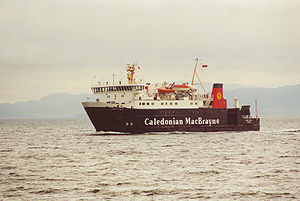- MV Lord of the Isles
-
MV Lord of the Isles 
Le MV Lord of the Isles en 2007Type Ferry Histoire Lancement 7 mars 1989 Mise en service 22 mai 1989 Statut en service Caractéristiques techniques Longueur 84,6 m Maître-bau 15,8 m Tonnage 3,504 Propulsion Diesel; 2 x Electric Bow Thrusters Vitesse 16 knots Autres caractéristiques Passagers 506 passagers, 56 voitures Équipage 28 Chantier naval Ferguson Shipbuilders, Port Glasgow Affréteur Caledonian MacBrayne Pavillon  Royaume-Uni
Royaume-UniIMO 8710869 modifier 
Le MV Lord of the Isles est un ferry de la compagnie Caledonian MacBrayne opérant depuis Oban sur la côte ouest de l'Écosse.
Sommaire
Histoire
Le Lord of the Isles, aussi appelé LOTI[1], a été lancé le 7 mars 1989 par les chantiers Ferguson Shipbuilders de Port Glasgow. Bien que basé à Oban pendant la majeure partie de son service, ce navire a également desservi la Clyde et les Hébrides.
Caractéristiques
Avec près de 85 mètres de long, le Lord of the Isles fait partie des plus grands navires de la flotte Caledonian MacBrayne. Assez similaire au MV Isle of Mull, sa poupe ressemble davantage au MV Hebridean Isles.
Le pont supérieur est équipé de salons, d'une cafétéria, d'un bar, d'une boutique et d'un salon d'observation à l'arrière du navire[2]. Des couchettes sont également disponibles pour les voyages les plus longs[1].
Le pont des voitures est quant à lui équipé d'un treuil permettant le chargement depuis les terminaux les plus anciens. La capacité maximale du navire est de 56 voitures et 506 passagers.
Service
Le Lord of the Isles est basé à Oban et dessert les routes vers Coll/Tiree et Barra/South Uist, combinant ainsi deux services. Son arrivée en 1989 a permis de libérer le Columba (1964) et le Claymore (1978), ré-organisant ainsi la flotte. En service à Oban depuis 9 ans, le navire a été interverti occasionnellement avec le MV Isle of Mull sur la route Uig - Ardossan. En 1998 le Lord of the Isles a été remplacé par le MV Clansman et transféré à Mallaig pour remplacer le MV Iona sur le service saisonnier vers Skye. Le navire est finalement retourné à Oban en 2003 pour desservir un grand nombre de routes aux côtés du MV Isle of Mull et du MV Clansman. Avec 7 îles sur sa route, le Lord of the Isles est le navire de la flotte ayant transporté le plus de passagers[2].
Notes et références
- (en) Cet article est partiellement ou en totalité issu de l’article de Wikipédia en anglais intitulé « MV Lord of the Isles » (voir la liste des auteurs)
- (en) Ian McCrorie, CalMac Ferries, CalMac (ISBN 0950716677)
- (en)History of MV Lord of the Isles, Ships of Calmac.co.uk. Consulté le 29-08-2007
Voir aussi
- Portail de l’Écosse
- Portail du monde maritime
- Portail des transports
Catégories :- Ferry
- Bateau des années 1980
- Transport en Écosse
- Bateau britannique
- Barra
- Caledonian MacBrayne
Wikimedia Foundation. 2010.
